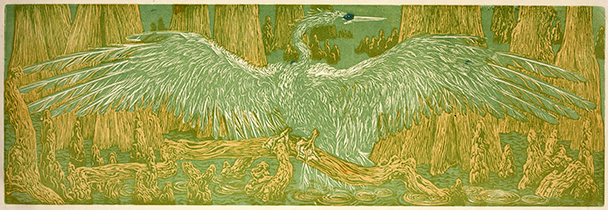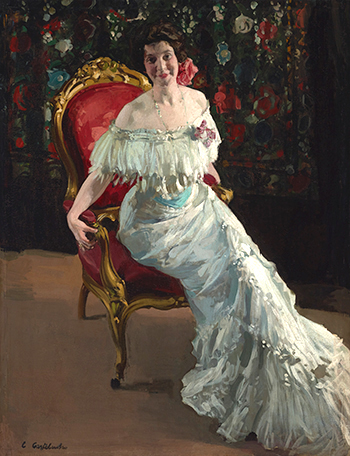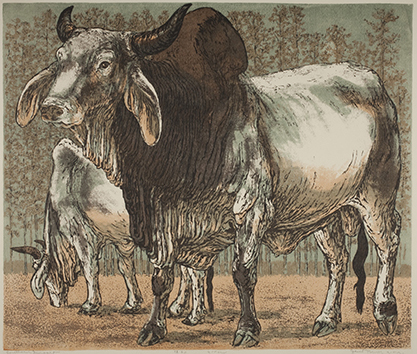Two new exhibits at the Meadows Museum
Two new exhibits featuring female artists have opened at the Meadows Museum.

From The Dallas Morning News:
Meadows Museum puts the sizzle on female artists with Texas roots in two new shows
By Michael Granberry
They were artists deeply rooted in Texas, although heavily informed by European and other global influences. And now, Marie Cronin, Carlotta Corpron and Janet Turner are the inspiration for two new shows at the Meadows Museum at Southern Methodist University.
 Bird of the Swamp by Janet Turner. |
“Between Paris and Texas: Marie Cronin, Portraitist of the Belle Époque” and “Process and Innovation: Carlotta Corpron and Janet Turner” will run concurrently from Sunday through June 5.
“These exhibitions spotlight the changing roles of female artists in the early and mid-1900s,” Meadows curator Nicole Atzbach said in a statement. “In the first years of the 20th century, Marie Cronin went to Paris, then the center of the art world, specifically to establish her career.
“Within a few decades, two more Texas-based artists Carlotta Corpron and Janet Turner, were pushing boundaries and influencing countless artists in their respective media of photography and printmaking.”
From the Meadows Museum:
Between Paris and Texas: Marie Cronin, Portraitist of the Belle Époque is the first monographic exhibition of Cronin’s (1867-1951) art and will feature a focused selection of her paintings, including works shown in the salons of Paris. Process and Innovation: Carlotta Corpron and Janet Turner presents the work of two pioneering artists working and teaching in Texas in the 1940s and 1950s, Carlotta Corpron (1901-1988) and Janet Turner (1914-1988).
|
Between Paris and Texas: Paris emerged in the nineteenth century as an art center of the Western world; a place of pilgrimage for artists both established and fledgling. As an alternative to France’s national academy, independent centers of artistic training sprouted up in the French capital in the latter decades of the nineteenth century; these stand-alone art schools provided a way to promote and foster the anti-establishment ideals and methods of the avant-garde. In the French capital in the opening years of the twentieth century, Marie Cronin (1867-1951), an artistic hopeful raised in East Texas, would cross paths with Catalan painter and renowned portraitist Claudio Castelucho (1870-1927). Nearly five years of study with Castelucho in Paris made a lasting impact on Cronin’s art. Upon her return to Texas, Cronin’s training abroad would enable her to secure important portrait commissions of Texas statesmen and political dignitaries. In subsequent years, Cronin had to balance her flourishing artistic career with the practicalities of running a family business when in the mid-1920s, Cronin fell into the position of presiding over a Texas railroad. While Marie Cronin studied with Castelucho, he painted a portrait of her that was exhibited widely in European salons as well as in the United States. A recent gift to the Meadows Museum, Castelucho’s portrait of Cronin exemplifies a rare intersection – that of an early Texan artist studying with a Spanish expatriate, both of whom converged in Paris to glean from that city’s modern innovators. As such, this portrait is the impetus and point of departure for Between Paris and Texas: Marie Cronin, Portraitist of the Belle Époque, on view at the Meadows from February 14 to June 5, 2016. This focused exhibition will feature the work of both master and student: alongside Castelucho’s portrait, on public display for the first time in over a century, Cronin’s paintings demonstrate her teacher’s influence, particularly those works created during the first decade of the twentieth century. Curated by Nicole Atzbach, Between Paris and Texas: Marie Cronin, Portraitist of the Belle Époque is the first monographic exhibition on this early Texas artist, who in many ways embodied the idea of women’s changing roles in the progressive era. On display will be works created by Cronin while abroad in Europe, as well as portraits executed stateside of Texas statesmen and American dignitaries. This exhibition hints at the enticement that European centers of art held for artists of the American West in the early twentieth century. With respect to Marie Cronin, the gathering of her work makes evident the lasting imprint of training and experiences accumulated while living in her beloved city of Paris. This exhibition has been organized by the Meadows Museum, and is funded by a generous gift from The Meadows Foundation. About the image: Portrait of Marie Cronin, c. 1906 by Claudio Castelucho y Diana (Spanish, 1870-1927); Oil on canvas. Meadows Museum, SMU, Dallas. Gift of the estate of Julia L. Hajdik, MM.2015.02. Photo by Michael Bodycomb.
|
Process and Innovation: Highly experimental, Carlotta Corpron (1901-1988) and Janet Turner (1914-1988) became masters of unorthodox methods in their corresponding media of photography and printmaking. As educators, both Corpron and Turner effected change in the concept of art education at their respective institutions, thus challenging their students to push beyond their own established boundaries. In 1935, Corpron moved to Denton to teach advertising design and art history at Texas State College for Women (now Texas Woman’s University). Subsequently requested to teach a course on photography, Corpron enrolled at the Art Center of Los Angeles in the summer of 1936 to polish her technique. Her dissatisfaction with routine subject matter led to Corpron’s realization that photographs did not have to be images of anything in particular; instead, light itself, and its dialogue with forms it encounters, could be the object of her photographic investigation. Guided by Corpron’s deliberate manipulations, seashells, eggs, scraps of paper and otherwise mundane props became transformative studies of patterns of light and dark. Described in 1983 by Michael Ennis in Texas Monthly as “the finest avant-garde photographer Texas has ever seen,” Corpron has been a lasting and immeasurable influence on students since her experimentation with light began forty years earlier. Working throughout her career primarily as a printmaker, Janet Turner likewise took her cue from the natural world. Just as Corpron subjugated nature to the primacy of light in varying degrees of abstraction, Turner displayed an absolute deference for nature – its power, its vulnerability, its often fragile relationship with humankind – manifested in her intricate prints distinctive for their rhythmic and technical complexity. After relocating in 1947 to Nacogdoches, Texas, to begin her newly appointed role of assistant professor of art at Stephen F. Austin State College (now Stephen F. Austin State University), Turner began to focus her attention on printmaking. A Guggenheim Fellowship she received in 1952 is generally considered to be the turning point in Turner’s career; it provided her the opportunity to carefully study her subjects in their natural habitats, and it also initiated her foray into combining printmaking techniques, which would become a lifelong hallmark of the artist. Fundamental in elevating the art of printmaking for future practitioners, Turner left a rich forty-year legacy of her own printed work and made printmaking’s creative potential seem almost limitless. Pushing boundaries in separate modes, both Corpron and Turner cast a wide net of influence over students and artistic contemporaries. Curated by Nicole Atzbach, Process and Innovation: Carlotta Corpron and Janet Turner explores the work of both artists from their early experiments in their respective media from midcentury. This exhibition draws entirely from holdings within the Dallas area including Bywaters Special Collections of SMU, which holds an impressive collection of art by both Turner and Corpron. Other loans come from private lenders, including Jack and Beverly Wilgus, who have generously promised their vast photographic collection to SMU’s DeGolyer Library. Images by Beverly Wilgus, a former student of Corpron, will also be on view.< This exhibition has been organized by the Meadows Museum, and is funded by a generous gift from The Meadows Foundation. About the image: Southern Import, 1953 by Janet Turner (American, 1914-1988); Serigraph. Janet Turner Collection, Jerry Bywaters Special Collections, Hamon Arts Library, SMU. |

